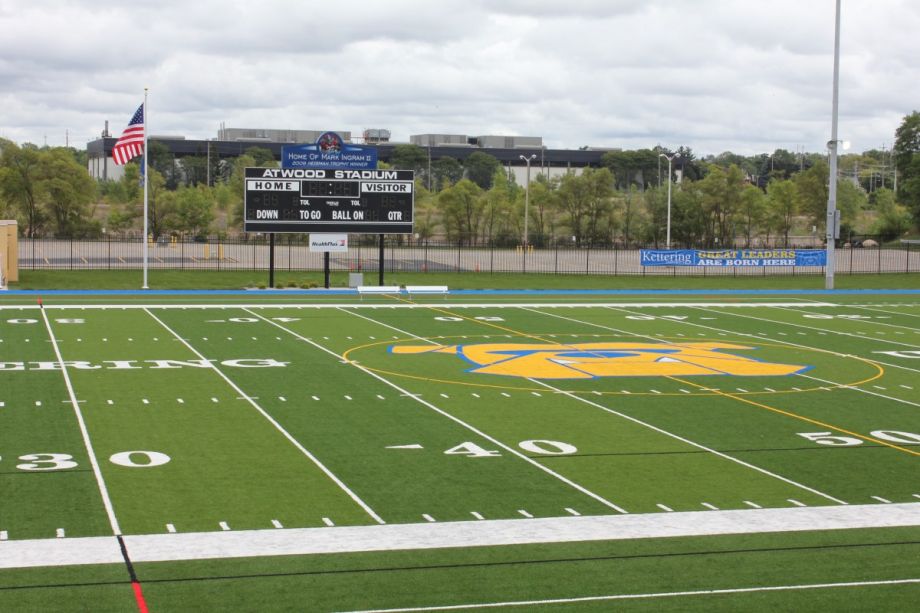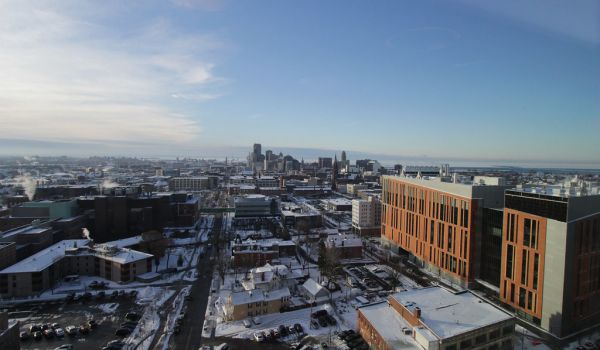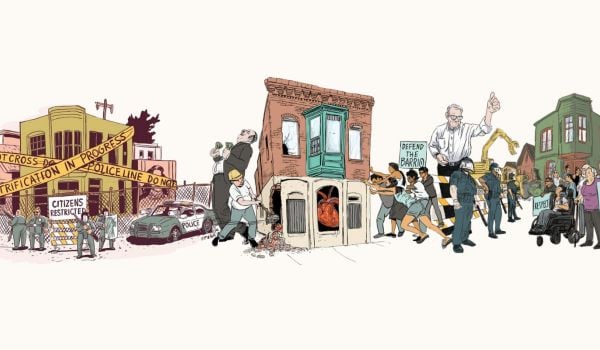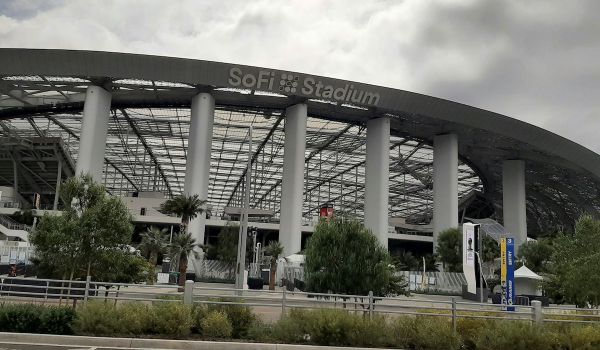Atwood Stadium sits on a beleaguered patch of land in Flint, Michigan, that stretches along University Avenue between downtown and the campus of Kettering University. The historic stadium, opened by the city in 1929, served as the showcase arena for the nation’s leading lights. Presidents Franklin D. Roosevelt and John F. Kennedy spoke there. Olympic medalist Jesse Owens cast awe on the track with his physical prowess. The UAW brought 9,000 union workers to the bleachers for a vote on a crucial national strike in 1946, and The Who had music fans on their feet. But most importantly, Atwood Stadium was a neighborhood anchor, a place where football games were played between high school teams with towering talent. On Thanksgiving Day in 1950, no fewer than 20,600 spectators showed up for a tussle between Flint Central and Flint Northern.
“It had 11,000 seats and only 300 parking spots,” says Kettering President Robert McMahan. “It was designed from the very beginning to be in the community, where people walked to games or parked in the neighborhoods.”
But as Flint’s fortunes dwindled, so did Atwood’s. It wasn’t lack of love, but lack of money that led to exposure and disrepair crumbling the stadium. No one, it seemed, could hold the decrepitude at bay. Atwood was stilled. It became largely a place of memory, of past-tense stories, rather than where life was lived.
Until now. In an unlikely turn of events, the City of Flint transferred ownership in 2013 of the stadium to Kettering — a private cooperative technical college founded as the School of Automotive Trades a decade before Atwood opened. They did it even though the school itself doesn’t have a football team. Over the following two years, the school raised funds for an extraordinary renovation of Atwood. The stadium re-opened with fanfare on August 27, 2015 with a classic game between two longtime Flint public school rivals. About 3,900 people attended, and afterward, fireworks broke brightly against the night sky.
It is a tricky thing when public treasures are sold off. It raises concern that what had once been held as a civic good — available for all, even if sometimes looking a little shabby — will instead exacerbate inequity. Would Atwood be lost to Flint residents, who still held the stadium dear? The University did, after all, remove the “Flint” lettering from center field. They replaced it with Kettering’s yellow Bulldogs logo.
McMahan remembers an exchange with one Flint man who runs a barbershop and had served on the city’s stadium authority, which managed Atwood on a volunteer basis. “Why are you doing this?” the man said to others in the authority as they considered the Kettering deal, according to McMahan. “Kettering will close that stadium down! We’ll never get in it!” McMahan responded: “But it’s closed now! You can’t use it now!”
But the point was pertinent. During the renovation, Atwood was set up as a public ice skating rink over the winters — a process that required two 40,000-gallon tanker trunks of water and the natural cold of Michigan winter. It was free, it had bright lights, and campus safety was mobilized to look over it. Community groups sold hot chocolate for their fundraisers. About 50 or 60 people came out every night.
In some ways, the rink was a tactical gift. “It was very important to signal to the community that this [renovation] was a community thing, not a university thing,” McMahan says.
The old stadium authority, too, is retaining a role as the Friends of Atwood. Led by Genesee County Circuit Judge Duncan Beagle, a longtime champion of the stadium’s revival, it will support its ongoing management. And finally, Kettering solicited and secured a donation to sponsor local high schools playing at Atwood for the first three years. Several teams now use the state-of-the-art stadium as their home field.
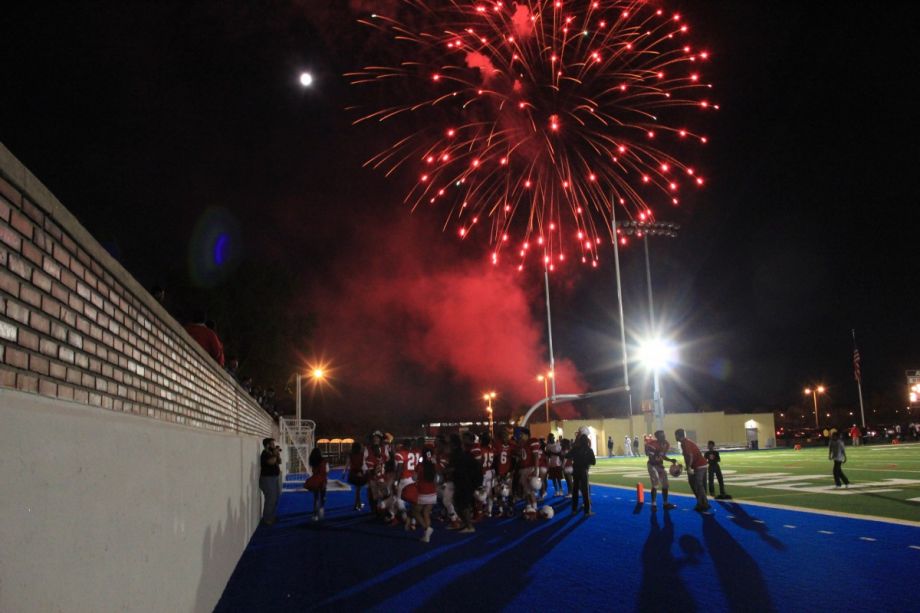
About 3,900 people attended the re-opening of Atwood Stadium, and several local high school teams now use it as their home field.
To renovate the stadium, Kettering raised over $2 million from the community and local stakeholders, as well as numerous pro athletes from Flint. Funds were used for in-depth geotechnical studies to inform the rehab work. The foundation was in such bad shape, 7,000 tons of material had to be trucked in to completely excavate and re-engineer it. Drainage, lighting and other systems were rebuilt. Bathrooms were repaired. Concession areas, fencing, locker rooms and seating were fixed up.
Most significantly, Kettering invested in the best available artificial turf possible — the expensive multilayered kind used by the National Football League. Originally, of course, Atwood had a grass field, but at some point, that was replaced with an early incarnation of turf, which wasn’t much more than a thin grass carpet on top of concrete. It gave the field a terrible reputation for injury, and contributed to its latter day disuse. (“Though bands would still use it for band competitions,” McMahan notes. “That’s still going on now, actually.”) The city simply didn’t have the resources to upgrade the turf. Today, though, Atwood is one of only three places in the state to use top-of-the-line turf, along with Ford Field where the Detroit Lions play, and the Big House at the University of Michigan.
“We decided early on not only to bring the stadium back, but to make a statement about Flint and about the richness of this facility,” McMahan says. “We put in that quality of material to send a message that Flint is worth it. It is worth that investment.”
The field was also expanded from its football-only design so that men’s and women’s soccer and lacrosse teams can also use it. At the same time, Atwood is integrated into Kettering’s campus recreational facilities. Students use it for flag football tournaments, and work-study students work the concessions during high school games. Atwood, then, has become an unlikely connection point between the Kettering community and the citizens of Flint, a democratizing space that has transitioned from being a distressed near-ruin to one of the finest athletic venues in the state of Michigan.
Atwood is not exactly an outlier in Kettering’s community outreach. Not long ago, Kettering purchased a party store near the university, and turned it into a mini-station for the Flint Police, serving neighborhoods around the university. It’s developing programs that encourage faculty to locate inside the city, and it’s constructing an automotive proving ground on a former General Motors industrial site. Working with the local land bank, McMahan says, Kettering has acquired about 200 properties around the university over the last three years, much of which has become green space.
“We make provisions in our budgets and staffing as we do this to make sure properties we have acquired, and the stadium is one of these, are not only attractive when they are finished, but they are maintained that way,” McMahan says. “It’s dramatically changed the appearance and the appeal and the livability of the city.”
The Atwood project also syncs with Imagine Flint, the city’s most recent master plan. In a sub-area plan focusing on University Avenue, the plan recommends relocating Atwood’s existing parking lot, which blocks access to the Flint Riverfront, and refurbishing the existing lot into parkland with indigenous plant life that accommodates a Flint River Trail.
Kettering, then, which had already taken over stadium management at the time of the plan’s release, was already seen as a partner in creating more public amenities, not fewer (at least under the current leadership). The overall strategy, the plan reads, “should be (to create) a new Flint Waterfront Park that integrates Atwood Stadium, the Flint River, and park space in a scenic, campus-like setting for the general public. … With thousands of people living, working, and studying within walking distance of the riverfront, it is important to provide scenic and meaningful public spaces for exercise, relaxation, and fellowship.”
It helps that McMahan’s circuitous path to the helm of Kettering included a stint as a senior adviser to the governor of North Carolina, where he focused on leveraging the state’s universities as catalysts for economic redevelopment. “You focus on key areas, and built out from there,” McMahan says.
Kimberly Roberson is a Flint-area native and director of the grantmaking team at the Charles Stewart Mott Foundation, which contributed substantially to the Atwood project; her dad played at Atwood as a high school student. Roberson feels that McMahan understands “Kettering as a community asset and a gathering place” with a role to play in the redevelopment of the University Avenue corridor, where the stadium sits like a sentinel. Bringing the stadium back, she says, contributes meaningfully to “the safety and vibrancy between the university and downtown. It’s really seen as an avenue, rather than an end.”
Indeed, as Atwood has awoken, people who moved out of the city are bringing their kids in for games and staying for dinner at nearby restaurants. Evening games, especially, have given the neighborhood more of a 24-hour economy feel. Foot traffic is up. People are exploring Flint. They are getting to know it again.
The Works is made possible with the support of the Surdna Foundation.

Anna Clark is a journalist in Detroit. Her writing has appeared in Elle Magazine, the New York Times, Politico, the Columbia Journalism Review, Next City and other publications. Anna edited A Detroit Anthology, a Michigan Notable Book. She has been a Fulbright fellow in Nairobi, Kenya and a Knight-Wallace journalism fellow at the University of Michigan. She is also the author of THE POISONED CITY: Flint’s Water and the American Urban Tragedy, published by Metropolitan Books in 2018.
Follow Anna .(JavaScript must be enabled to view this email address)


